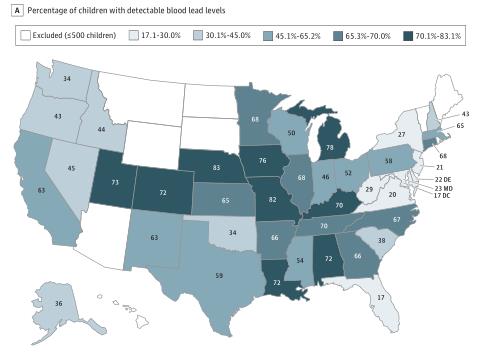Personal and social factors affecting children’s blood lead levels
- Why Botulinum Toxin Reigns as One of the Deadliest Poisons?
- FDA Approves Pfizer’s One-Time Gene Therapy for Hemophilia B: $3.5 Million per Dose
- Aspirin: Study Finds Greater Benefits for These Colorectal Cancer Patients
- Cancer Can Occur Without Genetic Mutations?
- Statins Lower Blood Lipids: How Long is a Course?
- Warning: Smartwatch Blood Sugar Measurement Deemed Dangerous
Personal and social factors affecting children’s blood lead levels
- Red Yeast Rice Scare Grips Japan: Over 114 Hospitalized and 5 Deaths
- Long COVID Brain Fog: Blood-Brain Barrier Damage and Persistent Inflammation
- FDA has mandated a top-level black box warning for all marketed CAR-T therapies
- Can people with high blood pressure eat peanuts?
- What is the difference between dopamine and dobutamine?
- How long can the patient live after heart stent surgery?
JAMA Pediatr: A study of personal and social factors affecting children’s blood lead levels
Research suggests that the factors that affect children’s blood lead levels include personal and social aspects, among which poverty and race are the most important factors.

Lead has no biological effect in the human body. Positive blood lead is abnormal and potentially harmful, no matter how severe it is, especially in children.
There is no safety threshold for children’s lead exposure, and the main literature believes that more than 5.0μg/dl is an elevated blood lead level (BLLs).
Researchers have recently examined personal and community factors related to blood lead levels in American children.
This cross-sectional retrospective study analyzed the results of blood lead testing performed by a large clinical laboratory from October 1, 2018 to February 29, 2020.
Participants were 1141441 children under the age of 6 from 50 U.S. states and the District of Columbia.
Participants’ personal demographic data were collected, including gender, age, and insurance type; community population data included housing, poverty, and major issues before the 1950s.
Race and ethnicity, geographic area, etc. The primary end point of the study is blood lead level, which defines blood lead level ≥1.0 μg/dL as blood lead positive, and ≥5.0 μg/dL as BLLs.
Among the children involved, there were 586,703 boys, with an average age of 2.3 years. More than half of the children had positive blood lead (576092, 50.5%), and 21,172 children were BLLs (1.9%).
In the multivariate analysis, children with public insurance were more likely to be positive for blood lead (adjusted odds ratio [AOR]: 2.01) and BLLs (AOR: 1.08). The risk of blood lead-positive and BLLs among children living in a house before the 1950s (blood lead-positive AOR=1.65, BLLs AOR=3.06) and the poorest quintile (blood lead-positive AOR=1.89; BLLs AOR=1.99) Higher.
Black, non-Hispanic and non-Hispanic children have a higher risk of blood lead positive (AOR=1.13), but there is no significant increase in the risk of BLL (AOR=0.83).

Positive rates of blood lead among children across the U.S.
Studies have concluded that the factors affecting children’s blood lead levels include personal and social aspects, of which poverty and race are the most important factors.
Original source:
Marissa Hauptman et al. Individual- and Community-Level Factors Associated With Detectable and Elevated Blood Lead Levels in US Children Results From a National Clinical Laboratory. JAMA Pediatr. September 27, 2021.
Personal and social factors affecting children’s blood lead levels
(source:internet, reference only)
Disclaimer of medicaltrend.org
Important Note: The information provided is for informational purposes only and should not be considered as medical advice.



